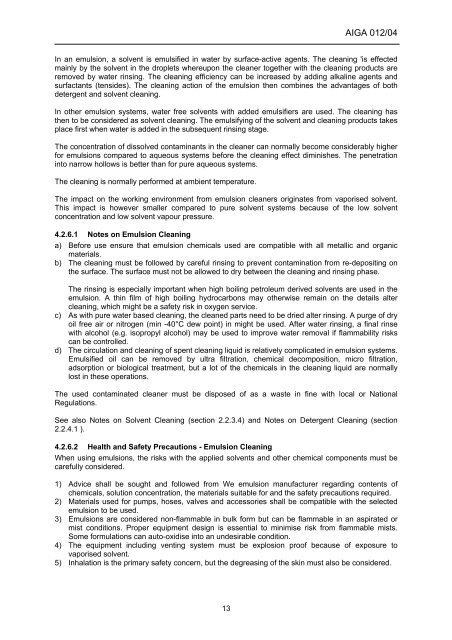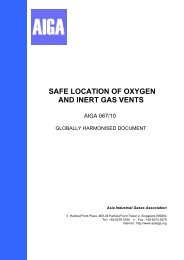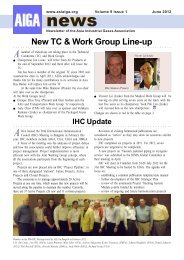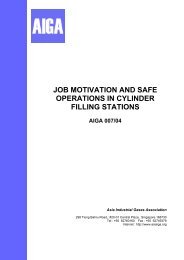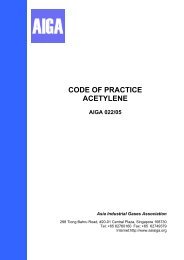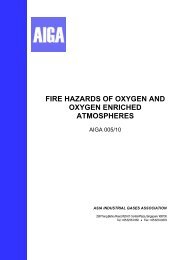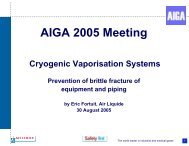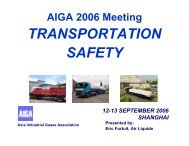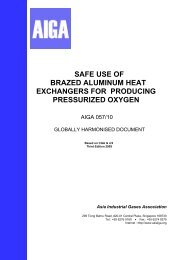CLEANING OF EQUIPMENT FOR OXYGEN SERVICE - AIGA
CLEANING OF EQUIPMENT FOR OXYGEN SERVICE - AIGA
CLEANING OF EQUIPMENT FOR OXYGEN SERVICE - AIGA
Create successful ePaper yourself
Turn your PDF publications into a flip-book with our unique Google optimized e-Paper software.
13<br />
<strong>AIGA</strong> 012/04<br />
In an emulsion, a solvent is emulsified in water by surface-active agents. The cleaning 'is effected<br />
mainly by the solvent in the droplets whereupon the cleaner together with the cleaning products are<br />
removed by water rinsing. The cleaning efficiency can be increased by adding alkaline agents and<br />
surfactants (tensides). The cleaning action of the emulsion then combines the advantages of both<br />
detergent and solvent cleaning.<br />
In other emulsion systems, water free solvents with added emulsifiers are used. The cleaning has<br />
then to be considered as solvent cleaning. The emulsifying of the solvent and cleaning products takes<br />
place first when water is added in the subsequent rinsing stage.<br />
The concentration of dissolved contaminants in the cleaner can normally become considerably higher<br />
for emulsions compared to aqueous systems before the cleaning effect diminishes. The penetration<br />
into narrow hollows is better than for pure aqueous systems.<br />
The cleaning is normally performed at ambient temperature.<br />
The impact on the working environment from emulsion cleaners originates from vaporised solvent.<br />
This impact is however smaller compared to pure solvent systems because of the low solvent<br />
concentration and low solvent vapour pressure.<br />
4.2.6.1 Notes on Emulsion Cleaning<br />
a) Before use ensure that emulsion chemicals used are compatible with all metallic and organic<br />
materials.<br />
b) The cleaning must be followed by careful rinsing to prevent contamination from re-depositing on<br />
the surface. The surface must not be allowed to dry between the cleaning and rinsing phase.<br />
The rinsing is especially important when high boiling petroleum derived solvents are used in the<br />
emulsion. A thin film of high boiling hydrocarbons may otherwise remain on the details alter<br />
cleaning, which might be a safety risk in oxygen service.<br />
c) As with pure water based cleaning, the cleaned parts need to be dried alter rinsing. A purge of dry<br />
oil free air or nitrogen (min -40°C dew point) in might be used. After water rinsing, a final rinse<br />
with alcohol (e.g. isopropyl alcohol) may be used to improve water removal if flammability risks<br />
can be controlled.<br />
d) The circulation and cleaning of spent cleaning liquid is relatively complicated in emulsion systems.<br />
Emulsified oil can be removed by ultra filtration, chemical decomposition, micro filtration,<br />
adsorption or biological treatment, but a lot of the chemicals in the cleaning liquid are normally<br />
lost in these operations.<br />
The used contaminated cleaner must be disposed of as a waste in fine with local or National<br />
Regulations.<br />
See also Notes on Solvent Cleaning (section 2.2.3.4) and Notes on Detergent Cleaning (section<br />
2.2.4.1 ).<br />
4.2.6.2 Health and Safety Precautions - Emulsion Cleaning<br />
When using emulsions, the risks with the applied solvents and other chemical components must be<br />
carefully considered.<br />
1) Advice shall be sought and followed from We emulsion manufacturer regarding contents of<br />
chemicals, solution concentration, the materials suitable for and the safety precautions required.<br />
2) Materials used for pumps, hoses, valves and accessories shall be compatible with the selected<br />
emulsion to be used.<br />
3) Emulsions are considered non-flammable in bulk form but can be flammable in an aspirated or<br />
mist conditions. Proper equipment design is essential to minimise risk from flammable mists.<br />
Some formulations can auto-oxidise into an undesirable condition.<br />
4) The equipment including venting system must be explosion proof because of exposure to<br />
vaporised solvent.<br />
5) Inhalation is the primary safety concern, but the degreasing of the skin must also be considered.


